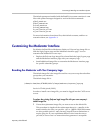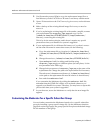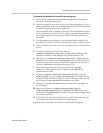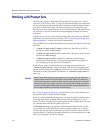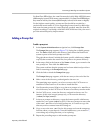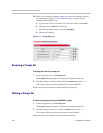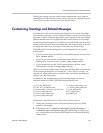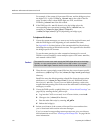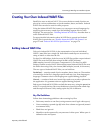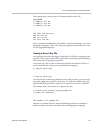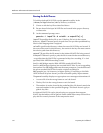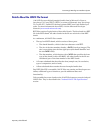
Customizing & Branding Your ReadiVoice System
Proprietary & Confidential 171
Creating Your Own Indexed WAVE Files
ReadiVoice uses an indexed WAVE file to store the short sound clips that are
played in various combinations to speak numbers, dates, and times. Indexed
WAVE files can also be used for other purposes.
Using the indexed WAVE file format, you can support several languages by
supplying the necessary sound clips and building separate files for each
language. The next section, “Building Indexed WAVE Files, describes how to
create indexed WAVE files.
For more detailed information about WAVE files in general and indexed
WAVE files in particular, see “Details About the WAVE File Format” on
page 175 and “Indexed WAVE File Specifications” on page 176.
Building Indexed WAVE Files
Polycom’s indexed WAVE file is the concatenation of several individual
WAVE (
.wav
) files into a single file. Individual sound clips are accessed by
using an index or offset into the file.
For InnoVox 480 bridges, both the source WAVE files and the output indexed
WAVE file store the audio data using 4-bit IMA ADPCM format
(8000 samples/second, 16-bit mono, compressed 4:1). For InnoVox 4000
bridges, both the source WAVE files and the output indexed WAVE file store
the audio data using 8-bit µ-law format (8000 samples/second, 16-bit mono).
The two types of indexed WAVE files you can build are:
Predefined — contains sound clips for numbers, dates, times, etc. The number
of sound clips in the file is language specific and may vary from language to
language. Grammar rules for the language are applied during playback.
Generic — contains a fixed set of sound clips used to say words or phrases for
the application. No grammar rules are applied during playback.
Both types of indexed WAVE files are built the same way, using the
genvoice
utility. You specify the key file to use, the directory location for the sound clips,
and the output file name. Only setting up the key file is different.
Key File Guidelines
Follow these formatting guidelines when creating key files:
• Each entry must be on one line (carriage returns aren’t legal white space).
• Lines containing a pound sign (
#
) in the first column are ignored (treated
as comment lines).
• Blank lines are ignored.
• Identifiers can be separated by any amount of white space. White space is
defined as tabs and spaces.



